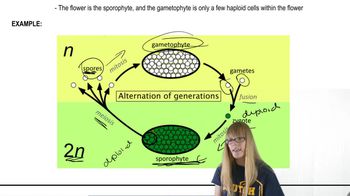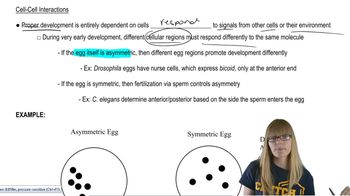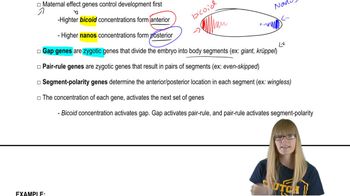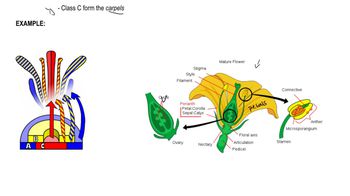Table of contents
- 1. Introduction to Genetics51m
- 2. Mendel's Laws of Inheritance3h 37m
- 3. Extensions to Mendelian Inheritance2h 41m
- 4. Genetic Mapping and Linkage2h 28m
- 5. Genetics of Bacteria and Viruses1h 21m
- 6. Chromosomal Variation1h 48m
- 7. DNA and Chromosome Structure56m
- 8. DNA Replication1h 10m
- 9. Mitosis and Meiosis1h 34m
- 10. Transcription1h 0m
- 11. Translation58m
- 12. Gene Regulation in Prokaryotes1h 19m
- 13. Gene Regulation in Eukaryotes44m
- 14. Genetic Control of Development44m
- 15. Genomes and Genomics1h 50m
- 16. Transposable Elements47m
- 17. Mutation, Repair, and Recombination1h 6m
- 18. Molecular Genetic Tools19m
- 19. Cancer Genetics29m
- 20. Quantitative Genetics1h 26m
- 21. Population Genetics50m
- 22. Evolutionary Genetics29m
14. Genetic Control of Development
Developmental Patterning Genes
Problem 18a
Textbook Question
The bristles that develop from the epidermis in Drosophila are evenly spaced, so that two bristles never occur immediately adjacent to each other. How might this pattern be established during development?
 Verified step by step guidance
Verified step by step guidance1
<Step 1: Understand the concept of lateral inhibition. Lateral inhibition is a process where a cell, once it starts to differentiate into a particular type, sends inhibitory signals to its neighboring cells to prevent them from adopting the same fate.>
<Step 2: Consider the role of Notch signaling pathway. In Drosophila, the Notch signaling pathway is crucial for lateral inhibition. It helps in the communication between adjacent cells to ensure that they do not differentiate into the same type of cell, such as bristle cells.>
<Step 3: Explore the role of proneural clusters. During development, groups of cells called proneural clusters have the potential to become bristle cells. However, only one cell from each cluster will become a bristle cell, while the others will be inhibited.>
<Step 4: Analyze the selection of the sensory organ precursor (SOP) cell. Within each proneural cluster, one cell is selected to become the SOP cell, which will eventually develop into a bristle. This selection is influenced by the Notch signaling pathway, which ensures that only one cell in the cluster becomes the SOP.>
<Step 5: Examine the spatial patterning. The even spacing of bristles is a result of the lateral inhibition and the selection of SOP cells. As each SOP cell inhibits its neighbors, it ensures that no two bristles form adjacent to each other, leading to the characteristic pattern seen in Drosophila.>
Recommended similar problem, with video answer:
 Verified Solution
Verified SolutionThis video solution was recommended by our tutors as helpful for the problem above
Video duration:
3mPlay a video:
Was this helpful?
Key Concepts
Here are the essential concepts you must grasp in order to answer the question correctly.
Pattern Formation
Pattern formation refers to the biological processes that lead to the spatial organization of cells and tissues during development. In Drosophila, this involves the regulation of gene expression and cell signaling pathways that dictate where and how structures like bristles will form. Understanding how these patterns emerge is crucial for explaining the even spacing of bristles.
Recommended video:
Guided course

Formation of Plant Gametes
Cell Communication
Cell communication is essential for coordinating developmental processes. In Drosophila, cells communicate through signaling molecules that influence neighboring cells' behavior, ensuring that bristles are spaced apart. This communication can involve mechanisms such as lateral inhibition, where a cell inhibits its neighbors from adopting the same fate, thus preventing adjacent bristles.
Recommended video:
Guided course

Cell-cell interactions
Genetic Regulation
Genetic regulation involves the control of gene expression that determines the characteristics of an organism. In the context of Drosophila bristle development, specific genes are activated or repressed to establish the pattern of bristle formation. Understanding the genetic pathways and regulatory networks that govern this process is key to explaining how the even spacing of bristles is achieved.
Recommended video:
Guided course

Regulation

 11:19m
11:19mWatch next
Master Segmentation Genes with a bite sized video explanation from Kylia Goodner
Start learningRelated Videos
Related Practice



